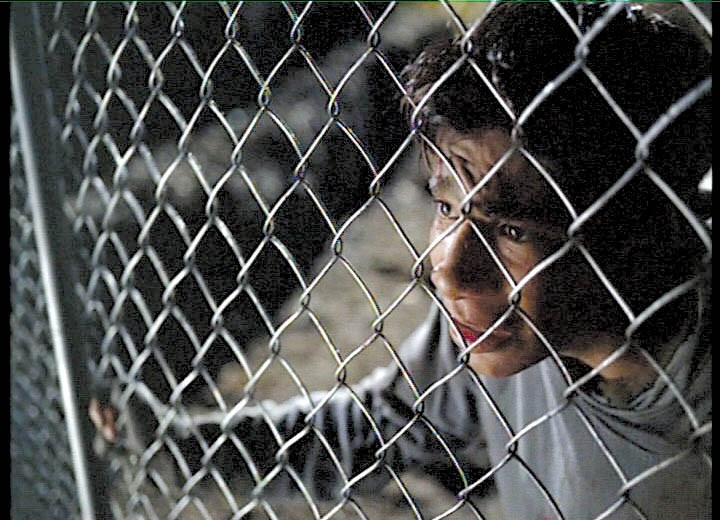The big party came and went, and now comes the morning after. Except that for the San Francisco International Film Festival, the hangover is painless and the future looks sunny. The only headaches are those of how to handle success.
Last year the SF International, the oldest film festival in the Americas, celebrated its fiftieth anniversary amidst much pageantry — tributes to George Lucas, Spike Lee, Robin Williams, and the festival’s founders; guest appearances by everyone from Saul Zaentz to Steve Buscemi; plus a whopping two hundred films from 54 countries. The movies themselves have always been the draw in San Francisco.
Unlike most of the world’s other “name brand” fests, SF doesn’t exist primarily as a marketplace for films to be picked up for subsequent commercial release and largely eschews the urge to stock the pond with box-office-champ Hollywood celebrities flown in for the occasion. As much as possible in the hurly-burly arena of cultural marketing, San Francisco is for the audiences, people who would show up to watch the latest Lebanese political drama or a first feature by a California film student even if they were screened on the side of a building. The Bay Area is renowned for its sophisticated, well-traveled film audiences, and the SF International wisely plays to its home base.
The 51st edition is the perfect hangover cure: a relatively modest 177 films from 49 countries, including 67 narrative features and 27 feature documentaries, screening at fewer venues (seven locations instead of eleven, including UC Berkeley’s Pacific Film Archive). Thus slimmed down, this year’s leaner fest does its best to throw a lifeline to festival-goers faced with the usual baffling array of choices. Some years are better than others for the quality of film releases around the world — if anything, the 2008 lineup does more with fewer films than last year. It certainly stretches the boundaries of the traditional festival. But how to choose? Some people rely on word of mouth, some on advertising and publicity. Others open the festival’s miniguide, close their eyes, and point to a film. Below is a smattering of tips, an informal guide to fifteen days when everything takes a back seat to sitting in a dark room full of strangers and transporting yourself to another place, another time.
It’s a pleasure to see genre at a film festival. It thickens the blood after the steady diet of art. Robert Guédiguian’s superior French crime pic Lady Jane achieves a Jean-Pierre Melville-style tone of cool, calm, collected impending violence in its tale of a trio of middle-aged crooks from director Guédiguian’s funky hometown of Marseille — played by hard-edged veterans Jean-Pierre (Le Poulpe) Darroussin, Ariane Ascaride, and Gérard Meylan — reuniting to avenge the kidnapping-murder of the Ascaride character’s son. Any actioner that can combine Vivaldi’s “The Four Seasons” on the soundtrack with Canned Heat’s “Fried Hockey Boogie” earns maximum bonus points. April 25, 27, and 29 at the Kabuki.
If Lady Jane represents neo-noir, the Preservation Screening Program showing of John M. Stahl’s newly restored Leave Her to Heaven (1945) is the real thing, a gorgeous film noir bursting with Technicolor, as if to contrast with the dark heart of Gene Tierney’s Ellen Berent. Ellen meets and marries novelist Richard Harland (Cornel Wilde) in a hurry, and when she feels edged out of her husband’s attentions, even by someone as innocent as Richard’s disabled younger brother (Darryl Hickman), she doesn’t hesitate to take twisted revenge. Ms. Tierney’s combination of glamour and potential menace was never captured more succinctly than by Jo Swerling’s screenplay and Stahl’s direction. Leave Her to Heaven plays Saturday, April 26 at the Castro, and Sunday, April 27 at the Pacific Film Archive.
While we’re in Genreville, let’s not overlook La Zona, a thriller with a social point by filmmaker Rodrigo Plá. The title refers to a gated development of McMansions in Mexico where the residents fear the crime outside the walls so much they’ve taken the law into their own hands — it’s vigilante death to anyone who trespasses. When some poor kids climb through a hole in the wall one night to rob a rich household, the ensuing retribution poses moral problems for the son of one of the most militant property owners. It’s the first feature release for the Uruguayan native Plá, now working in Mexico. May 3 at the Clay; May 5 and May 7 at the Kabuki.
All Is Forgiven (Tout est pardonné) is the type of serendipitous wonder we go to film festivals for. Seemingly nothing much happens. A fragile man named Victor (Paul Blain) alienates his wife Annette (Marie-Christine Friedrich) by his increasing heroin use and his general unreliability, they split up, and twelve years later Victor reunites with his teenage daughter, Pamela (Constance Rousseau), for an awkward but hopeful rapprochement. Blain’s performance is a heartbreaker, especially set against Rousseau’s. A fine addition to the literature of tender-souled junkies (there are more such movies than you might think), All Is Forgiven is the directorial debut of Mia Hansen Løve, a former actress and critic. Ms. Hansen Løve is expected to attend at least one of its four screenings. May 2 and 4 at the Clay; May 6 and 8 at the Kabuki.
The SF International has a classics division. Veteran auteurs Claude Chabrol and Eric Rohmer have been such frequent contributors that their fans could count on them practically every year. Chabrol’s A Girl Cut in Two, the prolific master’s 68th film, was reportedly inspired by the same real-life events as Milos Forman’s Ragtime, the murder of a rich old hedonist by a jealous young man, also rich, over a poor beauty. Chabrol’s wry version pits aging novelist François Berléand against hot-blooded playboy Benoît Magimel for the affections of TV talk-show host Ludivine Sagnier. It shows May 1 at the PFA. Chabrol is 77 years old. Rohmer is 88, and The Romance of Astrea and Celadon, his take on the ancient Gallic legend of a shepherd and a lady, would seem to clash with the contemporary settings of most of his work in the last thirty years. But this film may be his last. The PFA screening takes place April 29. Meanwhile, Italian director Ermanno Olmi (Il Posto) has decreed One Hundred Nails to be his final film as well. In it, a restless philosopher (Raz Degan) vandalizes one hundred old manuscripts by driving nails through them, then finds solace in a shack by the River Po, where he rediscovers the art of living simply. Olmi’s elegiac work plays Friday, April 25 at the PFA.
The village picture, a staple of film festivals since they first began, takes welcome new shape in several SFIFF offerings. In such low-key, often non-linear films as Thai director Aditya Assarat’s Wonderful Town and Huling Balyan Ng Buhi (or the Woven Stories of the Other) by Sherad Anthony Sanchez of the Philippines, we see a 21st-century experimental wrinkle on the familiar village formula — instead of straightforward sagas with deliberate narrative thrust, we explore the inner workings of the characters obliquely, with detours. An amiable example of this is Liew Seng Tat’s Flower in the Pocket, with two young Chinese-Malaysian brothers making their unsteady way through life without a mother, while their neglectful father tends to his mannequin workshop. It screens at the PFA on May 3.
In the same neo-village-pic vein is the beautiful Cochochi, by the Mexican directing team of Israel Cárdenas and Laura Amelia Guzmán. Another two young brothers, Evaristo and Tony from the indigenous Rarámuri people in the mountains of Chihuahua, undertake the task to deliver some medicine to their aunt on the other side of the sierra, and have adventures along the way. The boys are anything but carefree and they don’t speak unnecessarily. But they are dignified, and we are treated to the greenest, coolest, mistiest Mexico imaginable. See Cochochi May 5 at the PFA. Barcelona, as glimpsed inside the flat occupied by the characters in writer-director Ventura Pons’ Barcelona (A Map), is just a big village where a cross-dressing, terminally ill, Maria-Callas-worshipping former opera house usher and his equally complex wife preside over their eccentric house-share tenants — all of them with the rebellious, iconoclastic spirit that makes that Catalan city unique. You’ll have to trek to the Kabuki to see it, April 26 and 28, and May 1.
The lives of lower-middle-class African Americans in the Mississippi Delta make another neo-village-pic, Ballast, one of the best surprises of the year. The debut feature of Lance Hammer, who wrote, produced, directed, and edited it, Ballast deals with yet another pair of brothers in trouble — one living, one recent suicide — and the tough details of life in one of the poorest regions in the US. The cast of non-actors achieves poignancy no amount of trained preparation ever could. It opens commercially this summer, but you can catch it early at the PFA, May 2, with filmmaker Hammer. Among other films from the African-American experience, Barry Jenkins’ Medicine for Melancholy rings true for its romantic portrait of Micah and Joanne, a pair of “alternative” modern lovers negotiating their urban dreams in present-day San Francisco. It plays the PFA May 4, with Jenkins in attendance.
One more African-American-themed movie, Faubourg Tremé: The Untold Story of Black New Orleans, shows how one of the country’s oldest black neighborhoods viewed itself and its role in history, before and after Hurricane Katrina. Director Dawn Logsdon and writer/narrator Lolis Eric Ellie’s remarkable documentary gathers together a wealth of historical footage to show just how special the place was, and how it has changed. It’s at the Kabuki, May 3, 6, and 7.
The SFIFF takes a special interest in documentaries, and one of them is an absolute must-see despite its un-sexy subject. Fernando E. Solanas’ Latent Argentina laments the “mental colonialism” that caused that country to sell or give away most of its industry after the world’s economic powers (led by you-know-whom) decided that Argentina was to stop being a producer and to concentrate instead on supplying raw materials to multi-nationals. Want to know how Argentina became the “poor man of Latin America”? This doc explains, and praises its newfound resistance to privatization. It plays the PFA on Sunday, April 27.
South American overtures of a different kind are the subject of Theodore Thomas’ Walt & El Grupo, a splendid record of Walt Disney’s 1941 sojourn in Brazil, Argentina, and Chile, ostensibly to foster good will and gather material — Disney was really escaping from a strike at the Mouse House (April 26, 28, and 30 at the Kabuki). John Gianvito’s Profit Motive and the Whispering Wind (Sunday, May 4 at the PFA) achieves a remarkable “people’s history” of the US simply by showing memorials to massacred Native Americans, slave rebellions, labor martyrs, civil rights champions, and other progressive folks, with only the sound of the wind through tall grass and trees on the soundtrack.
Two docs take skeptical looks at China’s economic boom: Du Haibin’s Umbrella, in which consumer-crazy factory workers contrast with university graduates who can’t find a job except in the army (April 29, May 2 and 8 at the Kabuki); and Up the Yangtze, Yung Chang’s portrait of the life-altering effects of the massive Three Gorges Dam project (PFA, May 8). More worthwhile docs: Peter Galison and Robb Moss’ US security deconstruction, Secrecy (PFA, May 5); The Judge and the General, a study of the legal case against Gen. Augusto Pinochet in Chile, by Elizabeth Farnsworth and Patricio Lanfranco (PFA, May 6); Stranded, Gonzalo Arijon’s harrowing account of a 1972 airline crash in the Andes that forced its survivors to resort to cannibalism (Kabuki, April 27, 29, and May 1); and, just for fun, Cachao: Uno Más. The April 28 screening of Dikayl Rimmasch’s exuberant musical profile of the late Cuban mambo king at the Kabuki is followed by a Cachao memorial concert at Yoshi’s San Francisco.




















